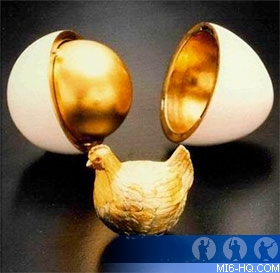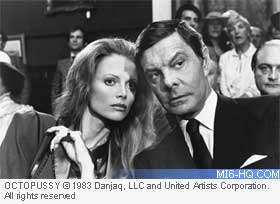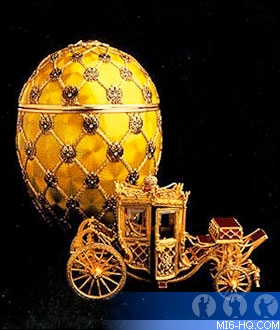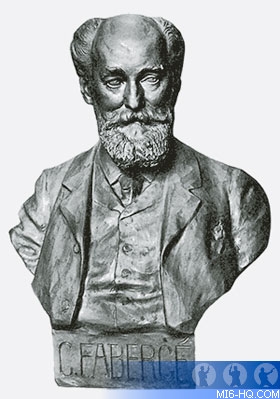 |
| |
MI6 investigates the back-plot to 1983's Octopussy
and the story of Carl Fabergé's famous jewel-encrusted
eggs... |
|
The Fabergé Connection
26th December 2007
Carl Gustavovich Fabergé was born on
30 May 1846 in St. Petersburg, Russia. Fabergé was prominent
jeweler and metalwork artist, best known for the creation of
the Fabergé Eggs - a range of highly ornate, near-priceless
artworks in the tradition of Easter Eggs. This highly valued
items were also used as a plot device in the 1983 James Bond
film "Octopussy".
After higher education,
Fabergé and younger brother Agaton took over the
family business in 1872. With a name in the trade the
brothers quickly impressed and were appointed official
jewelers of
the court. The first of the Fabergé eggs was commissioned
by Tsar Alexander III as an Easter gift for his wife.
This was far simpler than those that would be created
over the
later years - a white gold casing that opened to a golden
yoke, on which a hen perched.
Between 1885 and 1917, Fabergé and his skilled team of workers crafted 57 eggs. Each Easter, Fabergé provided his highly decorative works to the Russian royals. Each egg is hand carved from a different precious metal and gilded with a variety of gems and each more spectacular and lavish than the previous.
|
|
 Above: The first of 57 eggs crafted
by Fabergé
Above: The first of 57 eggs crafted
by Fabergé |
Long after his death in 1920, Fabergé's
amazing artwork collides with legendary pop-icon, James Bond.
The plot idea for the Fabergé auction originates from Ian
Fleming's 1963 short story, "Property of a Lady"..
Published in "Octopussy
and the Living Daylights" (1966), Fleming's hard-warn
spy is on the tail of a KGB officer who bids over the mark for
an already costly Fabergé Egg in order to pay off a hired
hit-man.

Above: Kamal Kahn and Magda in the Sotheby's auction house in 1983's Octopussy... |
|
The title of the story,
and indeed the plot, had long been speculated to become
the premise for the next in the long line of Bond pictures
after "For Your Eyes Only" wrapped. Yet it wasn't until
Michael Wilson, screenwriter of 1983's "Octopussy", snapped
up the
idea that
Fabergé and
Bond crossed paths on screen. While the title "The Property
Of A Lady" is yet to be used,
the movie version of Octopussy weaves in the plot of the
short story as well as several of Fleming's other works.
In the film adaptation 007 bids on the Fabergé Egg
to force the villainous Kamal
Kahn into bidding higher to retrieve what believes is
a genuine, priceless Fabergé Egg. In reality, 007
swaps the egg with a fake at the auction house, poaching
the real egg and letting Kahn go away with a worthless trinket.
|
Bond travels to India in pursuit of Kahn and
his forgers, using the real Fabergé (which Kamal thinks
is the fake) as a bargaining chip. The forgers reclaim the egg
from 007, thanks to the feminine charm of Magda,
and Bond is captured. Kahn's counterpart, a Russian General
Orlov, seals the fate of the cursed Egg, crushing it with
the butt of his gun.
The prop egg used by the
1983 filmmakers is not a true Fabergé design, but
is in the style of the Coronation Egg, which Fabergé gifted
to Tsar Nicholas in 1897. Real Fabergé Eggs
are priceless and safely kept in museums, art galleries
or private collections.
However, trinkets and model reproductions
can be purchased in the form of ornaments or jewelry
for between 60 and 300 USD. The James Bond prop has also
been
replicated for sale and from time to time copies appear
on the internet, ranging between 300 and 600 USD - the
buying power of 007 is clear in this case!
Today the Fabergé Egg is most certainly an icon of both fine art and jewelry and synonymous with high-class luxury and the finest detail of style. The Fabergé family lends its name to a range of cosmetics and perfumes. In October 2007 it was announced that the Fabergé brand was set to be reformed by 2008 to reflect the family interests and heritage.
|
|
 Above: The most famous Fabergé creation, the 1897 Coronation Egg.
Above: The most famous Fabergé creation, the 1897 Coronation Egg. |
In the News
The Riverfront Arts Centre in Delaware was recently host to the
most comprehensive Fabergé exhibition
ever - collecting works from private collections across the world.
The Rothschild egg of 1902 recently
made the news when
it was sold for a world record breaking £8.9 million. It
was brought at Christie's auction house by a private art collector.
The Christie's auction was the first time the Rothschild egg
had been on display in public since its creation.
The Complete Fabergé Imperial Collection
1885: Hen
1886: Hen with Sapphire Pendant
1887: Blue Serpent Clock
1888: Cherub with Chariot
1889: Necessaire
1890: Danish Palaces & Spring Flowers
|
|
1891: Memory of Azov
1892: Diamond Trellis
1893: Caucasus
1894: Renaissance & Resurrection egg
1895: Rosebud & Twelve Monograms
1896: Revolving Miniatures & Alexander III Portraits |
 |
|
1897: Coronation & Doweger
1898: Lilies of the Valley
1898: Mauve Enamel
1899: Bouquet of Lilies Clock & Pansy
1900: Trans-Siberian Railway & Cockerel
1901: Basket of Wild Flowers & Gatchina Palace
1902: Clover Leaf & Empire Nephrite
1903: Peter the Great & Danish Jubilee
1906: Moscow Kremlin & Swan
1907: Rose Trellis & Cradle with Garlands
1908: Alexander Palace & Peacock
1909: Standart Yacht & Alexander II Commemorative
1910: Colonnade & Alexander III Equestrian
1911: Fifteenth Anniversary & Bay Tree
1912: Czarevich & Napoleonic
1913: Romanov Tercentenary & Winter
1914: Mosaic & Grisaille
1915: Red Cross with Triptych & Red Cross with Imperial Portraits
1916: Steel Military & Order of St. George
1917: Constellation & Karelian Birch
|
Carl Gustavovich Fabergé passed away on the 24th of September 1920 in Switzerland, leaving the business to his sons Eugené and Alexander. Carl was laid to rest next to his late wife in the Cimetière du Grand Jas in Cannes, France.
Related Articles
 Octopussy
& The Living Daylights
Octopussy
& The Living Daylights
 Octopussy
- Production Notes
Octopussy
- Production Notes
 Octopussy
- Movie Coverage
Octopussy
- Movie Coverage